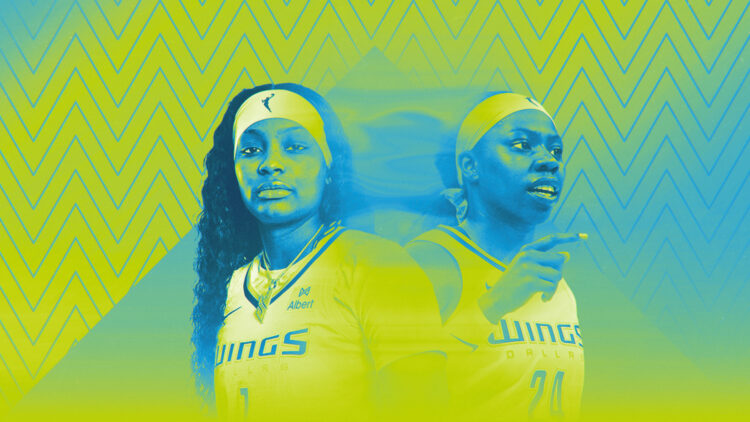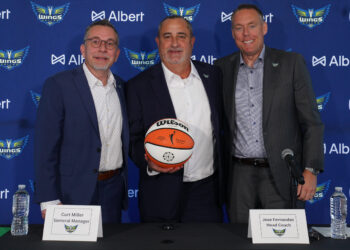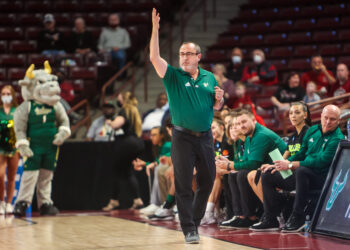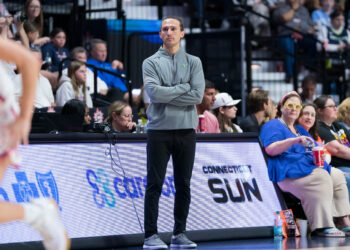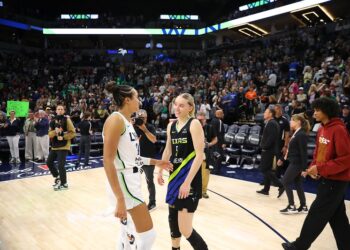The Dallas Wings’ acquisition of NaLyssa Smith, an intriguing one at the time the deal was first reported, eventually wound up as part of a blockbuster four-team trade that saw Curt Miller recommit to building around Arike Ogunbowale in 2025 and beyond, even while losing fellow superstar Satou Sabally. And while Smith hitting the ground running this year is crucial to Dallas having any chance of establishing themselves in the race for playoff position, there’s an argument to be made that the long-term growth of the on-court relationship between Smith and the Wings’ franchise cornerstone Ogunbowale will help both players continue to evolve while motivating them, in spite of the considerable options on offer in next winter’s free agency, to extend their relationships with the organization into 2026.
The key for rookie head coach Chris Koclanes, then, is maximizing the unique two-player dynamics that a confident, physically imposing ball handler like Smith and an explosive all-world scorer like Ogunbowale can create. Whether in simple pick-and-roll situations that force defenders (and opposing coaches) into complicated decisions about throwing bodies at Ogunbowale or in more modern dribble-hand-off (DHO) actions that sometimes eliminate the decision altogether, there is loads of potential to offer for Dallas—especially if Koclanes can extract Smith’s full potential in ways Indiana sometimes struggled to do.
In pick-and-roll actions, defenses are already faced with a tough decision when Ogunbowale is the ball handler, thanks to her ability to score at all three levels. With the soft touch Smith has consistently demonstrated on floaters from just outside of the restricted area, she’s a perfect fit to take a quick pocket pass and finish with the defense out of shape. At the same time, Smith has also shown a semi-reliable ability to offload the ball to others when opportunities arise. If Ogunbowale has drawn the defense’s attention at the point of attack, Smith has the chance to guide a four-on-three power play behind the double and find teammates in favorable positions around the basket or awaiting kickouts in the corners.
The crafty finishing skills and occasional offloads around the basket (mind you, just 1.0 assists per game [APG] last season) can provide incremental value, but Smith’s ability to put the ball on the floor to attack size mismatches or off-balance defenses in DHO situations could be a much more consistent threat for Dallas. Thanks to her above-average athleticism for a player of her size (6’4”), the former Baylor forward is a nightmare for opposing defenses when she’s on her own, and WNBA teams—including the Fever a year ago—regularly use DHO sets with the strong side of the floor cleared out. If Smith gets the ball in those situations with Ogunbowale dragging her defender into the action for a true two-on-two game, there are few favorable outcomes left for the opposition.
If the defenders switch, it doesn’t matter if Smith keeps the ball or pitches it to Ogunbowale. Smith’s size against almost any perimeter player who is tasked with guarding Ogunbowale will register as an immediate mismatch, and her confidence as a ball handler means she’s capable of attacking downhill without the clumsiness that old-school forwards might have had. At the same time, her first step is quick enough to ensure that even a moment of defensive indecision during the hand-off will likely result in an easy lay-in as weak-side defenders scramble across to try and meet her at the basket.
In the alternate scenario, the vast majority of players big enough to handle an interior threat like Smith want nothing to do with Ogunbowale on a switch as the guard’s otherworldly ball-handling skills can expose most bigs’ lack of relative mobility. The result of those switches will usually be a high-quality look for Ogunbowale and more counters from the defense as the game goes on—with doubles off of Smith (or another of Dallas’ offensive options) a near inevitability if Arike can catch fire.
Even in the best case scenario for the opposition, where defenders stay attached to their original match-ups, there’s an obvious threat for the Wings. If the strong side of the floor (where the DHO is taking place) is otherwise empty, one of Ogunbowale (if she’s in movement towards the open corner) or Smith (if the guard is headed towards the top of the arc) is going to end up with a chance to attack along the baseline one-versus-one. There’s a select set of W defenders who are ready to handle the blend of size and speed that Smith offers, but many will find it difficult to contend with both of her physical tools in isolation (though her finishing can still improve).
Granted, it won’t always be easy for the Wings to exploit the advantages the duo can create—especially given Smith’s lack of success shooting the three ball over the last two seasons (29.2 percent on 1.6 attempts per game) and new frontcourt partner Teaira McCowan’s general aversion to outside shooting (11 three-point attempts [3PA] across six WNBA seasons). An occasional problem for Dallas in the last few seasons (particularly in the non-Sabally minutes) has been the lack of spacing their more traditional frontcourt rotation has provided, and Smith is not a player who immediately rectifies that.
She’s comfortable playing at the three-point line—as evidenced by the five and, especially, four out looks that Christie Sides showcased at times a season ago—but her comfort at the arc didn’t always result in tight defensive coverage when she was deployed there. With analytics more prevalent than ever, many coaches have increasing levels of comfort with open players at the perimeter, and a sub-30-percent shooter won’t register massive alarm bells in that context. The result last season was often an extra defender closer to the paint—undermining Smith’s ability to drive while simultaneously making life more difficult for teammates like Aliyah Boston (a more traditional inside threat like McCowan) and Kelsey Mitchell (a willing downhill attacker like Ogunbowale).
So, how does Koclanes realize all of the benefits of Smith’s unique player profile and potential alongside Ogunbowale without sacrificing his team’s spacing? The key, as with many things in basketball, will likely be a certain degree of balance. One solution could be a semi-regular usage of small-ball line-ups with Smith at the five and Swiss army knife Myisha Hines-Allen at the four after the seventh-year vet shot a solid 36.0 percent last season on limited volume (1.3 3PA) last season. Other options like Maddy Siegrist (27.0 percent) and Joyner Holmes (19.4 percent) can offer variety but were also inefficient from three last season. Either of those two or others like DiJonai Carrington trending back towards previous career highs (37.1 percent in ‘23, before dropping to 25.0 last year) from three would also help quickly increase the number of well-spaced line-ups Koclanes can field.
Regardless, Dallas should still expect to play lots of minutes with both McCowan and Smith on the floor together next season, and crowded paints are likely to be a consequence of that pairing unless Smith can trend back towards her own career-best mark from long range (38.1 percent as a rookie in 2022). Koclanes, of course, will also look to lean on his background in player development to help Smith evolve in many facets in 2025, but the ultimate finding from this season may be that this frontcourt pair needs a tweak to realize the overall potential of Dallas’ intriguing new core of Ogunbowale, Carrington, and their top pick in April’s draft.
Whatever the case, Smith maximizing her productivity in Dallas is the ideal outcome for all involved as the fourth-year forward can boost her upcoming contract, Ogunbowale can unlock an ideal partner for the two-player game, and the Wings—as an organization—would gain a critical bargaining chip to help keep their All-WNBA cornerstone in Texas long-term.
All stats through the 2024 season. Unless otherwise noted, all stats courtesy of Basketball Reference
